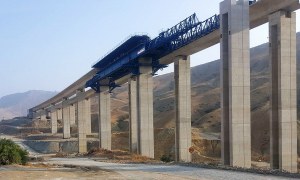🕑 Reading time: 1 minute
Corrosion of the cables of suspension bridges is one of the factor causing deterioration of the bridge structure. The causes and prevention of corrosion of suspension bridge cables is discussed. Main cables in suspension bridge structure are used to carry bridge floor structure and the main cable is commonly connected to towers. So, the safety and integrity of main cables are greatly affecting the bridge structure performance. There are many factors that affect corrosion of main cables in suspension bridges and these factors should be considered properly for the safety of the bridge structure. The corrosion of main cables should be tackled, and this may be obtained by specifying the source of the problem and then introduce proper solutions.
Fig.1: Main Cable in Suspension Bridge Structure
Contents:
Corrosion Protection for Main Cables of Suspension Brides
The corrosion of main cables of suspension bridge is very likely and frequently to occur. This is because keeping moisture out of the cable is difficult to achieve because the main cable commonly experiences considerable movements due wind forces and seasonal temperature fluctuation. As a result, layers such as coating area provided for water exclusion will be damaged and the cable will be exposed to aggressive materials. The majority of coatings do not have adequate elasticity or durability to make rooms for deformations caused by temperature variations and wind forces. It is reported that, suspension bridge main cable ,which protected using wrapping wire with past and coated using proper painting and the painting rehabilitated regularly, have suffered deterioration. So, several approaches have been used to as a corrosion protection measures for main cable protections and these methods will be discussed in the following sections:- Wrapping main cable of suspension bridge
- Corrosion inhibitors
- Dry air or dehumidification technique
Wrapping Main Cable of Suspension Bridge
Various materials such as plastic, neoprene and others have been used to wrap main cables and prevent the aggression of water to avoid cable deterioration. Commonly, this strategy is considered after the cable has suffered certain degree of deterioration. Such measures do not provide satisfactory result since not only does it cover deteriorated areas and hence it hides such region from inspectors but also retain moisture which exacerbate the situation. It shown that entire waterproofing of suspension bridge main cables using different wrapping wires and materials and painting is not possible, and hence moisture cannot be kept out of the main cables with this strategy.Use of Corrosion Inhibitors
Corrosion inhibitors like linseed oil based materials can be used for main cables to stop or entirely avoid corrosions and deterioration of cables caused by corrosion. The oil compound is provided at the saddles of the suspension bridge and then it would move down the main cables to cover entirely or most of the cable surface. In this case, cable bulging and oil leakage may occur at the lower part of the main cable. This measure has been considered in the United States in numerous cases, but its application has been decreased nowadays.Dry Air or Dehumidification Technique
This method developed to overcome the issue of keeping moisture away from main cables which the aforementioned measures could not tackle completely. In this technique, galvanized wire is used which is a corrosion resistance material if humidity is kept under 40 percent. The humidity can be maintained low artificially by moving dry air through and along the length of the main cables of suspension bridges. Details of dehumidification system are provided in Figure-2. Dry air is injected or blew at low pressure approximately 3000 Pa into the main cable through inlet points which are provided at specific spacing along the length of the cable, and the air is made to travel along the cable and exits at various outlet points which are provided along the cable length. The spacing of inlet and outlet points considerably influence the effectiveness of the system, so it is recommended to take advantage of the experience of other bridges retrofitted using this system.
Fig.2: Detail of dehumidification system used to protect main cables of suspension bridge from corrosion attack due to moisture
It is required to adequately airtight the cable along its entire length and at the top of towers, cable bands and other saddle cover. However, this requirement cannot be met easily, and various materials and methods have been tried to achieve such purpose. For example, elastomeric wrapping as shown in Figure 3 which applied over wire wrapping and paint, and there are cases in which elastomeric paint is used instead of wire wrapping.
Fig.3: Elastomeric Wrapping of Suspension Bridge Main Cable
This system has been used for many bridges in different countries such as Japan and United Kingdom and examples of the application of this system are shown in Figure 4 and Figure 5.
Fig.4: Dehumidification Vent of Main Cable of Suspension Bridge

Fig.5: Dehumidification retrofit of main cables to keep relative humidity low and consequently prevent corrosion of the bridge main cable
Read More: Towers of Suspension and Cable Stayed Bridges -Functions and Conceptual Design Cable Supported Bridge Conceptual Seismic Design and its Components Types of Bridges Based on Span, Materials, Structures, Functions, Utility etc.

